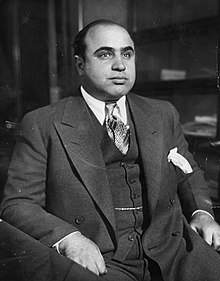
Al Capone (1899–1947) is one of the most notorious American gangsters of the 20th century and has been the major subject of numerous articles, books, and films. Particularly, from 1925 to 1929, shortly after Capone relocated to Chicago, he enjoyed status as the most notorious mobster in the country. Capone cultivated a certain image of himself in the media, that made him a subject of fascination.[1][2] His personality and character have been used in fiction as a model for crime lords and criminal masterminds ever since his death. The stereotypical image of a mobster wearing a pinstriped suit and tilted fedora are based on photos of Capone. His accent, mannerisms, facial construction, physical stature, and parodies of his name have been used for numerous gangsters in comics, movies, music, and literature.
